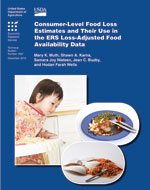Consumer-Level Food Loss Estimates and Their Use in the ERS Loss-Adjusted Food Availability Data
- by Mary K. Muth, Shawn A. Karns, Samara Joy Nielsen, Jean C. Buzby and Hodan Farah Wells
- 1/3/2011
Overview
The Food Availability (per capita) Data System developed by USDA's Economic Research Service tracks annual food and nutrient availability for many commodities. The Food Availability data series in this system overstates actual consumption, so ERS has included an additional series, the Loss-Adjusted Food Availability data, to adjust the Food Availability data for nonedible food parts and food losses, including losses from farm to retail, at retail, and at the consumer level. In this report, we propose new consumer-level loss estimates for "cooking loss and uneaten food" of the edible share to replace those currently used in the Loss-Adjusted Food Availability data and propose their adoption for the entire data span (1970 to the most recent year in the series). The proposed loss percentages are calculated by subtracting food consumption estimates from food purchase or availability estimates for each food. These calculations are adjusted with information from an expert panel experienced in analyzing food consumption data. In general, the proposed food loss estimates for individual foods indicate substantial differences from the currently used estimates. Although some estimates indicate smaller loss percentages than the currently used estimates, many are larger. Overall, if the proposed loss estimates are used in the ERS loss-adjusted series, the average American would consume 17.3 pounds less each year, or 41.9 fewer calories per day, than suggested by the currently used loss estimates.
Download
-
Entire report
Download PDF -
Report summary
Download PDF

